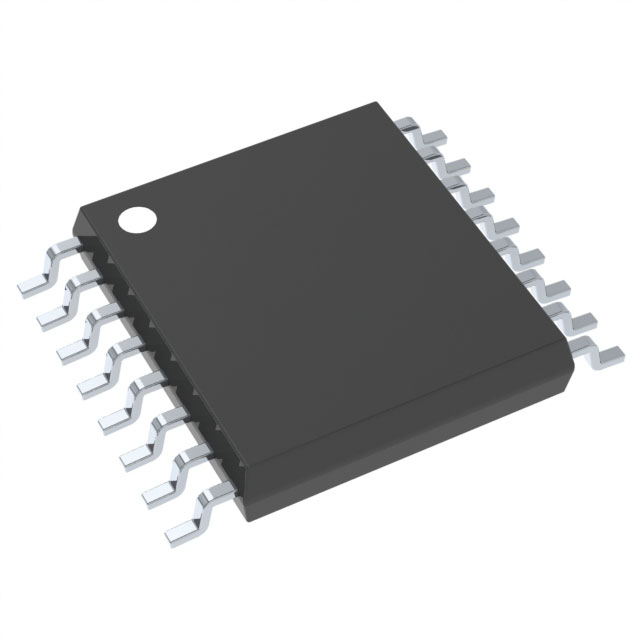CD4543BPWR
Introduction
The CD4543BPWR is a semiconductor integrated circuit belonging to the category of CMOS BCD-to-Seven-Segment Latch/Decoder/Driver. This device is widely used in electronic display applications, offering characteristics such as low power consumption, high noise immunity, and ease of interfacing with various digital systems. The package type for the CD4543BPWR is TSSOP, and it is available in reel packaging with a quantity of 2500 units per reel.
Specifications
- Supply Voltage Range: 3V to 18V
- Input Current: ±1µA
- Operating Temperature Range: -55°C to 125°C
- Output Current: 6mA
Pin Configuration
The CD4543BPWR has a total of 16 pins, each serving a specific function in the device's operation. The detailed pin configuration is as follows: 1. A - Segment A input 2. B - Segment B input 3. C - Segment C input 4. D - Segment D input 5. E - Segment E input 6. F - Segment F input 7. G - Segment G input 8. LT - Latch Enable input 9. BI/RBO - Blanking Input/Ripple Blanking Output 10. RBI - Ripple Blanking Input 11. a - Lamp Test Output 12. b - Blanking Output 13. c - Decimal Point Output 14. VDD - Positive Power Supply 15. GND - Ground 16. LE - Latch Enable
Functional Features
The CD4543BPWR serves as a BCD-to-seven-segment latch/decoder/driver, providing the capability to convert binary-coded decimal (BCD) input into the corresponding seven-segment display output. It includes features such as latch enable, lamp test, and blanking functions, making it suitable for a wide range of display applications.
Advantages and Disadvantages
Advantages
- Low power consumption
- High noise immunity
- Wide operating voltage range
- Easy interfacing with digital systems
Disadvantages
- Limited output current capacity
- Requires external components for driving displays
Working Principles
The CD4543BPWR operates by latching the BCD input and decoding it to drive the corresponding segments of a seven-segment display. The latch enable input allows the device to store the BCD data, while the blanking and lamp test functions provide additional control over the display output.
Application Field Plans
The CD4543BPWR finds extensive application in electronic display systems, including digital clocks, digital meters, and instrumentation panels. Its ability to interface with various types of seven-segment displays makes it suitable for diverse consumer and industrial electronics products.
Alternative Models
For users seeking alternatives to the CD4543BPWR, several alternative models are available in the market, including the CD4511B, CD4026B, and SN74LS47. These devices offer similar BCD-to-seven-segment decoding functionality and can be considered based on specific application requirements.
In conclusion, the CD4543BPWR is a versatile semiconductor device that plays a crucial role in driving seven-segment displays across a wide range of electronic applications. With its low power consumption, high noise immunity, and ease of interfacing, it continues to be a popular choice for designers and engineers in the field of digital electronics.
Word Count: 413
10個與CD4543BPWR在技術方案中應用相關的常見問題與解答
What is CD4543BPWR?
- CD4543BPWR is a BCD-to-7 segment latch/decoder/driver IC, commonly used to convert binary-coded decimal (BCD) input into a 7-segment display output.
What is the maximum voltage supply for CD4543BPWR?
- The maximum voltage supply for CD4543BPWR is typically 18V.
What is the purpose of CD4543BPWR in technical solutions?
- CD4543BPWR is used to interface BCD data with 7-segment displays, making it suitable for applications such as digital clocks, electronic meters, and panel meters.
How many BCD inputs does CD4543BPWR support?
- CD4543BPWR supports 4 BCD inputs, allowing it to handle numbers from 0 to 9.
What are the typical output current capabilities of CD4543BPWR?
- CD4543BPWR can typically sink up to 25mA per segment and source up to 10mA per segment.
Can CD4543BPWR directly drive common-cathode or common-anode displays?
- Yes, CD4543BPWR can be configured to drive either common-cathode or common-anode 7-segment displays.
What is the recommended operating temperature range for CD4543BPWR?
- The recommended operating temperature range for CD4543BPWR is usually -55°C to 125°C.
Does CD4543BPWR have built-in latches for the BCD inputs?
- Yes, CD4543BPWR includes built-in latches for the BCD inputs, allowing for stable operation.
Can CD4543BPWR be cascaded to drive multiple 7-segment displays?
- Yes, CD4543BPWR can be cascaded to drive multiple 7-segment displays, making it suitable for applications requiring multiple digits.
Are there any specific precautions to consider when using CD4543BPWR in technical solutions?
- It's important to ensure proper decoupling and bypass capacitors are used to minimize noise and voltage spikes, and to carefully follow the recommended operating conditions outlined in the datasheet.


